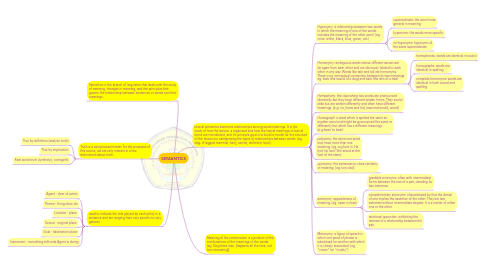SEMANTICS
by nurmeida urwani


1. Semantics is the branch of linguistics that deals with the study of meaning, changes in meaning, and the principles that govern the relationship between sentences or words and their meanings.
2. used to indicate the role played by each entity in a sentence and are ranging from very specific to very general.
2.1. Agent - doer of action
2.2. Theme - thing done do
2.3. Location - place
2.4. Source - original place
2.5. Goal - destination place
2.6. Instrument - something taht aids Agent in doing
3. Truth is a complicated matter. for the purposes of this course, we are only interest in a few distinctions about truth.
3.1. True by definition (analytic truth)
3.2. True by implication
3.3. Real world truth (synthetyc, contigent)
4. Lexical semantics examines relationships among word meanings. It is the study of how the lexicon is organized and how the lexical meanings of lexical items are interrelated, and it’s principle goal is to build a model for the structure of the lexicon by categorizing the types of relationships between words. (eg. dog: 4-legged mammal, hairy, canine, definitely loyal.)
4.1. Hyponymy: a relationship between two words in which the meaning of one of the words includes the meaning of the other word. (eg. color: white, black, blue, green, etc.)
4.1.1. superordinate: the word more general in meaning
4.1.2. hyponyms: the words more specific
4.1.3. co-hyponyms: hyponyms of the same superordinate
4.2. Homonymy: ambiguous words whose different senses are far apart from each other and not obviously related to each other in any way. Words like tale and tail are homonyms. There is no conceptual connection between its two meanings. eg. bark (the sound of a dog) and bark (the skin of a tree)
4.2.1. homophones: words are identical in sound
4.2.2. homographs: words are identical in spelling
4.2.3. complete homonyms: words are identical in both sound and spelling
4.3. Homophony: the case where two words are pronounced identically but they have different written forms. They sound alike but are written differently and often have different meanings. (e.g. no, know and led, lead and would, wood)
4.4. Homograph: a word which is spelled the same as another word and might be pronounced the same or differently but which has a different meanings. (e.g.bear/ to bear)
4.5. polysemy: the same one word may have more than one meaning. (eg. e.g.foot in :He hurt his foot/ She stood at the foot of the stairs)
4.6. synonymy: the sameness or close similarity of meaning. (eg. boy=lad)
4.7. antonymy: oppositeness of meaning. (eg. open x close)
4.7.1. gradable antonyms: often with intermediate forms between the two of a pair, standing for two extremes.
4.7.2. complementary antonyms: characterized by that the denial of one implies the assertion of the other. They are two extremes without intermediate degree. It is a matter of either one or the other.
4.7.3. relational opposites: exhibiting the reversal of a relationship between the pair.
